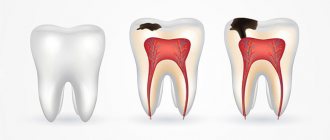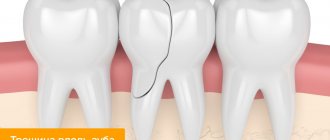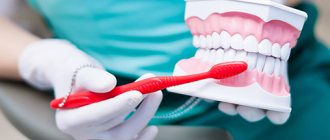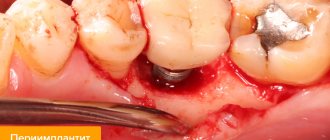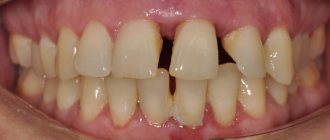Tooth enamel
is the protective outer shell that covers the teeth. It is responsible for performing very important functions - preventing the destructive effects of external aggressive factors on teeth and ensuring aesthetic appeal. It is because of this that it is necessary to take timely care of the preservation and restoration of enamel.
Increased abrasion of tooth enamel is one of the forms of non-carious damage to dental tissues, which is characterized by their premature thinning.
Bad habits, medications, too hard food, poor-quality dental prosthetics are factors that influence the excessively rapid erasure of enamel. It is their exposure that contributes to the development of oral diseases. The thinning of the protective layer occurs gradually and, as a rule, the first signs of such changes can be seen on the incisors. This is why it is so important to undergo systematic preventive examinations with a dentist.
Due to thinning of the enamel, early pathological abrasion of the tooth occurs, which causes further damage to dentin. As a result, the patient experiences sharp edges of the enamel, which can injure the mucous membrane of the cheeks and lips.
Content
- When should you start taking care of your teeth?
- Why does enamel wear off?
- What to do if the enamel wears off
- The enamel is worn off, teeth hurt - what to do?
- Solving the problem yourself
Poor dental health can cause dangerous illnesses. The health of these organs is especially important in a person’s life, since any food must be chewed well, and with unhealthy or missing teeth this is not easy. The front teeth experience high stress when eating food, and it is important that their enamel is complete. Worn enamel, among other things, deprives a person of the opportunity to smile, and his attractiveness is lost.
Three stages of diagnosis
Diagnosis is carried out during a dental examination:
- The location of the erosive defect is identified by drying the tooth surface with an air jet and applying iodine.
- The process of differentiating erosion from a wedge-shaped defect and primary stage caries. Erosion from caries will be distinguished by the location and shape of the lesion, as well as a smooth surface; with caries, the surface becomes rough. The wedge-shaped defect will also differ in shape and location. It is found in the area of the tooth root.
- In order to identify concomitant pathologies of the endocrine system, an examination is carried out by an endocrinologist and gastroenterologist, an ultrasound of the thyroid gland is prescribed, and a hormonal analysis of the thyroid gland is performed.
When should you start taking care of your teeth?
The correct answer is from the prenatal period. It is from this time that the expectant mother should saturate her body with vitamins and calcium and take vitamin and mineral complexes specially created for pregnant women. A professional dentist will help in this matter.
Breastfeeding is important for a newborn baby, because mother's milk will provide the baby with everything necessary for proper development, including teeth.
When the child gets older, parents introduce him to sweets - this is the first factor that destroys teeth. From this moment on, there is a danger of caries. If there is not enough calcium, the enamel will be destroyed in childhood.
To avoid such danger, the mother must:
- Reduce consumption of sugar and fructose;
- Protect yourself from any diseases so as not to cause hypoplasia in the unborn child - underdevelopment of tooth enamel;
- Feed your baby breast milk, because the share of sugar in infant formula is up to 30%;
- Minimize the amount of cookies and sweets in the child’s diet;
- Take vitamins as prescribed by your dentist.
The consequences of erosion are dire
Erosion affects mainly middle-aged people. This process is characterized by a long-term course and can last from 10 to 15 years. The following consequences of damage to tooth enamel can be identified:
- Tooth wear accelerates.
- As dentin is exposed, the color of the teeth changes and they become darker.
- As the enamel wears away, the sensitivity of the teeth on the inner and outer surfaces worsens, that is, touching the tongue and lips brings discomfort. Dentin is a soft tissue, so pain will inevitably occur when air enters, chewing and exposure to food acid contained in food.
- The edges of the front teeth may appear more translucent.
Why does the enamel on teeth wear off?
Scientists identify several reasons:
- Bad habits - biting pencils and nails, alcohol and nicotine;
- Straight bite;
- Sharp closing of the jaws during stress, bruxism;
- Violation of metabolic processes;
- Work in hazardous industries - in the field of metallurgy, in coal mining, in confectionery shops;
- Using brushes with hard bristles;
- Inappropriate bleaching;
- Culinary preferences (hot tea with ice cream, for example).
PROMOTION
Hygienic teeth cleaning
2000 rub.
Stages and phases of destruction development
The disorder is classified not only by stages of development, but also by phases:
- The active phase is characterized by a progressive process of loss of tooth tissue, which causes excessive susceptibility of teeth to the action of various irritants. The enamel is destroyed very quickly, the size of the erosion increases every month.
- The stabilized phase occurs very slowly. Characterized by less severe pain. This is due to the fact that as the defect forms, the formation of tertiary dentin is observed, which is a product of the vital activity of the pulp and acts as a kind of protective barrier.
It is very important that in some cases the disease may transition from one phase to another.
There are 3 stages of disease development:
- initial, there is damage to the purely upper layer of enamel;
- medium, the enamel is affected so deeply that erosion reaches the dentin;
- deep, the enamel is completely affected, and the upper layer of dentin is also affected.
Enamel has worn off, teeth hurt – what to do?
Seek help from a dentist and begin treatment. Various methods and drugs are used to eliminate the problem. It is impossible to restore the enamel, but the use of drugs will make it harder and protect it from further destruction. Scientists are working to create drugs that can restore worn enamel. The implementation of this task will be a truly great discovery.
Rehabilitation therapy
Treatment for erosion of tooth enamel involves the appointment of local and general procedures in order to transition the disease from the active phase to the stable one. At the same time, the loss of hard dental tissues will be stopped.
If the enamel has already been worn away, then the following are prescribed:
- Local therapy includes remineralization - daily procedures of application of fluoride and calcium-containing products. The course lasts from two to three weeks. The final stage will be coating the surface of the teeth with fluoridated varnish. These procedures eliminate the increased susceptibility of enamel to irritants.
- Mineralization is carried out using calcium electrophoresis.
- If there is a high level of damage to the hard tissues of the tooth and an obvious erosive defect, a tooth restoration procedure is carried out using a light-curing composite, veneer or artificial crown.
- General therapy involves the prescription of medications with calcium and fluoride, as well as a complex of vitamins and minerals.
- Treatment of erosion in the stabilized phase involves continued use of the vitamin complex. Also, therapeutic methods at this stage will be aimed at eliminating discoloration of the areas affected by erosion. To do this, methods of polishing teeth with a special paste, moderate whitening and applying fluoride varnish and gel to erosive areas are used.
In case of erosion, filling a tooth will not always be effective, since a violation of the adherence of the filling material may occur, which can lead to the formation of a defect around the filling itself.
Treatment will be considered effective if the erosions smooth out and become invisible, pain when eating and getting air into the mouth disappears.
Characteristic symptoms
The longer the patient ignores the problem, the more pronounced its manifestations will be. Associated symptoms include the following:
- sensitivity of enamel to temperature contrasts, mechanical stress,
- darkening of teeth,
- surface roughness,
- at more advanced stages, visible signs appear - wrinkles around the mouth, reduction in the size of the lower jaw,
- problems with chewing food, certain diction disorders,
- Frequent biting of lips and cheeks from the inside.
Teeth become sensitive
Often patients are faced with a wedge-shaped defect, which is characterized by gradual exposure of the roots. Lack of necessary treatment will ultimately lead to problems with the functioning of the masticatory muscles and jaw joints.
What treatment methods are used today?
If the patient has discovered that teeth have begun to wear away in the early stages, he may be offered therapeutic ways to correct the problem. As part of the treatment, applications are prescribed using drugs to strengthen dental tissues and reduce hyperesthesia - increased sensitivity. These can be gels, solutions or pastes for treating the surface of teeth. Also, sealing of dentinal tubules and restoration with composite materials are carried out. Let's look at the main treatment options in more detail.
Prosthetics with crowns
Orthopedic treatment involves the installation of crowns, which, in turn, are created from modern metal ceramics or zirconium dioxide. The design allows you to completely restore the appearance and functionality of the tooth. Thus, a high-quality metal-ceramic crown costs approximately 11-12 thousand rubles, while a structure made of zirconium dioxide can cost the patient 20, or even 30 thousand.
This is what zirconium crowns look like
Installation of the core inlay followed by fixation of the crown
If the tooth decay is sufficiently severe, it may be suggested to fix the stump inlay, which follows the shape of the canals as accurately as possible. As a result, the crown holds firmly in place and copes well with the chewing load. The main thing is that the root is preserved. If there are no inflammatory processes in the surrounding tissues, the tab will last quite a long time. The cost of the solution excluding the crown will be 4,000 – 8,000 rubles.
Microprosthetics with veneers and lumineers
Prosthetics using the thinnest ceramic overlays on teeth will not only stop further thinning of the enamel, but also provide a high level of smile aesthetics - correct minor defects, such as large interdental spaces, chips and cracks, and also make the enamel color dazzlingly white. Obviously, this pleasure is not cheap - the cost varies from 15 to 65 thousand rubles for 1 veneer. On the other hand, if you spare no expense and get high-quality veneers from a trusted brand, you can enjoy a perfect Hollywood smile for 10 years or more. It is worth immediately noting that microprosthetics is not carried out for bruxism and severe bite pathologies - first you will have to solve these problems, and only then will it be possible to install onlays.
The photo shows ceramic veneers
“I encountered this problem after removing my braces. The teeth, of course, fell into place, but the upper incisors became very thin. The doctor said it was because of the crowding I had. After much thought, I finally decided to get veneers. Cool stuff, I tell you. There is no need to undergo whitening, and the shape and thickness of the teeth are immediately restored..."
Katerina V., 29 years old, St. Petersburg, fragment of correspondence on a thematic forum
Root restoration with implants
If the roots are damaged, the teeth will have to be removed, and the best option for replacing them will be crowns or dentures on implants. Since in such situations it is most often necessary to restore most of the elements of the row or the entire row, it is worth considering modern one-stage implantation protocols, which involve immediate loading of the prosthetic structure - on the same day or a maximum of a week later. The world's leading implant manufacturers offer various root implantation technologies that make it possible to firmly fix the prosthesis on 3, 4, 6 or 10-12 implants without prior bone growth, even in conditions of pronounced bone resorption and the presence of inflammatory processes. It should be noted that implantation is the only possible way to fully restore a smile and stop jawbone atrophy.
Implantation using the All-on-4 protocol
Read more about how much an implant costs today in our special material>>>
